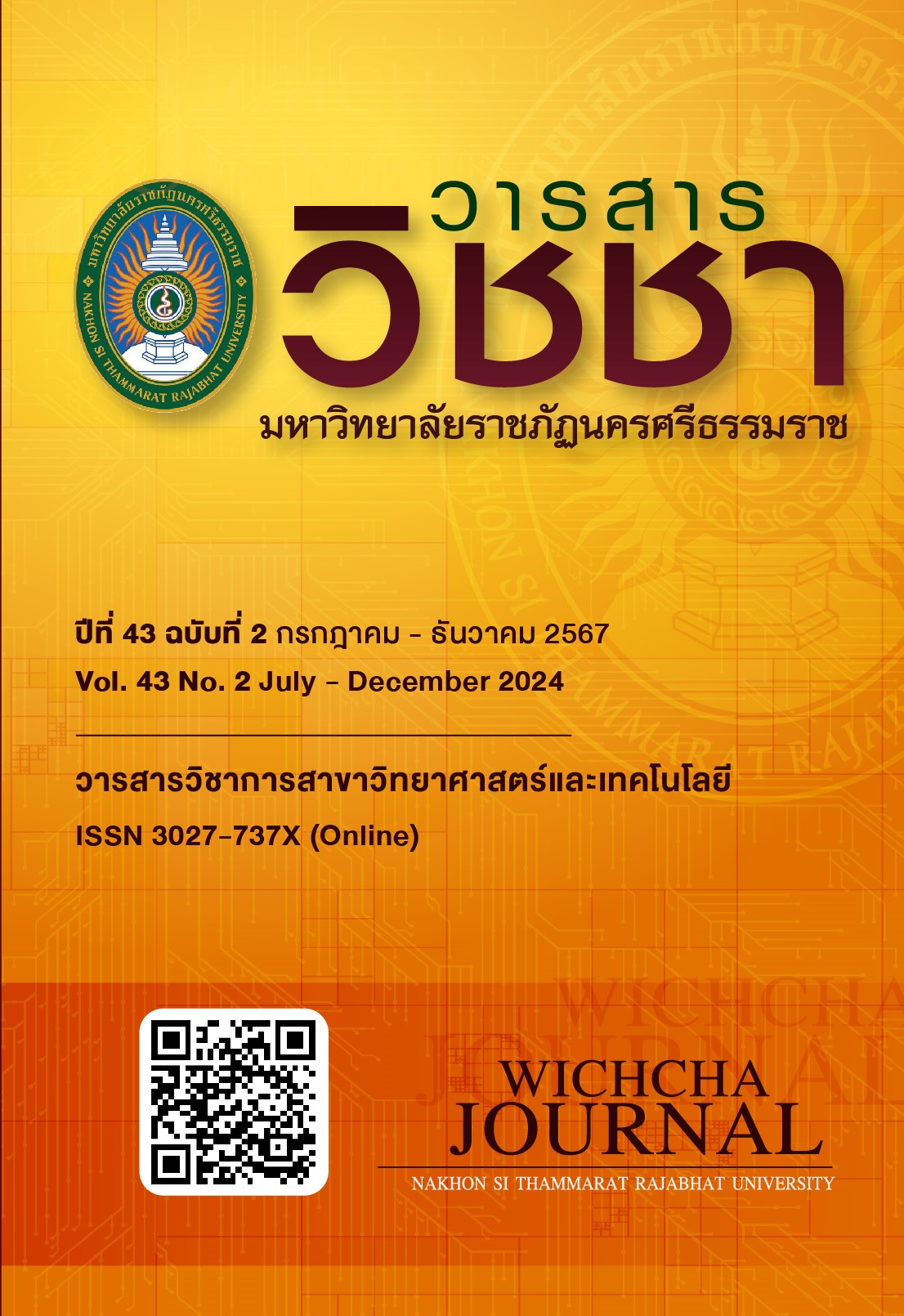The Adsorption of Malachite Green Dye Using Biochar from Bagasse
Main Article Content
Abstract
The purpose of this research was to prepare and characterize biochar from sugarcane bagasse, a community waste material. The prepared biochar sugarcane bagasse was applied as an absorbent material for Malachite Green dye (MG) treatment in wastewater by adsorption. Biochar from bagasse was prepared by burning bagasse powder in an anaerobic state at 450 °C for 3 h. The morphology of the biochar sorbents from bagasse was determined by X-ray diffraction (XRD) and scanning electron microscopy (SEM). The functional groups were studied by fourier transform infrared spectroscopy (FT-IR). Biochar from the prepared bagasse was applied as an adsorbent to remove malachite green dye from wastewater. The effects to be studied are the amount of adsorbent, dye concentration, adsorption period, and acid-base conditions (pH). The results showed that, using the SEM technique, the surface characteristics of biochar from bagasse were rough and higher porosity than normal bagasse. Confirmation of main functional groups by the FT-IR technique. Biochar from the prepared bagasse was applied as an adsorbent to remove malachite green dye from wastewater. As a result of malachite green dye adsorption, it was found that when the amount of adsorbent and the pH value increased, the dye adsorption efficiency increased, while increasing the dye concentration resulted in a decrease in the dye adsorption efficiency. Biochar from bagasse has a dye adsorption efficiency (97.11%) higher than regular bagasse (94.96%). In addition, the results of the reuse test showed that biochar from bagasse could be reused more than five times with a dye adsorption efficiency higher than 80.00%. This research can be used as a guideline for waste material modification. In agriculture, it can be used as an adsorbent material for wastewater treatment.
Article Details

This work is licensed under a Creative Commons Attribution-NonCommercial-NoDerivatives 4.0 International License.
เนื้อหาและข้อมูลในบทความที่ลงตีพิมพ์ในวารสารวิชชา มหาวิทยาลัยราชภัฏนครศรีธรรมราช ถือเป็นข้อคิดเห็นและความรับผิดชอบของผู้เขียนบทความโดยตรง ซึ่งกองบรรณาธิการวารสารไม่จำเป็นต้องเห็นด้วยหรือร่วมรับผิดชอบใด ๆ
บทความ ข้อมูล เนื้อหา รูปภาพ ฯลฯ ที่ได้รับการตีพิมพ์ในวารสารวิชชา มหาวิทยาลัยราชภัฏนครศรีธรรมราช ถือเป็นลิขสิทธ์ของวารสารวิชชา มหาวิทยาลัยราชภัฏนครศรีธรรมราช หากบุคคลหรือหน่วยงานใดต้องการนำข้อมูลทั้งหมดหรือส่วนหนึ่งส่วนใดไปเผยแพร่ต่อหรือเพื่อการกระทำการใด ๆ จะต้องได้รับอนุญาตเป็นลายลักษณ์อักษรจากวารสารวิชชา มหาวิทยาลัยราชภัฏนครศรีธรรมราชก่อนเท่านั้น
The content and information in the article published in Wichcha journal Nakhon Si Thammarat Rajabhat University, It is the opinion and responsibility of the author of the article. The editorial journals do not need to agree. Or share any responsibility.
References
กรมควบคุมมลพิษ. (2565). ปัญหาน้ำเสียชุมชน. สืบค้นเมื่อ 10 พฤศจิกายน 2565, จาก: https://www.pcd.go.th/waters/%e0%b8%a3%e0%b8%b9%e0%b8%9b%e0%b9%81%e0%b8%9a%e0%b8%9a%e0%b8%a3%e0%b8%b0%e0%b8%9a%e0%b8%9a%e0%b8%9a%e0%b8%b3%e0%b8%9a%e0%b8%b1%e0%b8%94%e0%b8%99%e0%b9%89%e0%b8%b3%e0%b9%80%e0%b8%aa%e0%b8%b5%e0%b8%a2-page-1-2/.
กิตติยา ปลื้มใจ กรองทิพย์ เติมเกาะ เอกรัฐ มีชูวาศ และวิษณุ เพชรภา. (2563). การวิเคราะห์สมบัติทางความร้อนและหมู่ฟังก์ชั่นของเซลลูโลสจากชานอ้อย. วารสารผลงานวิชาการ กรมวิทยาศาสตร์บริการ, 9(9), 31-37.
กิติโรจน์ หวันตาหลา ชยาภาส ทับทอง และสินศุภา จุ้ยจุลเจิม. (2550). การดูดซับสีย้อมผ้าด้วยถ่านกัมมันต์ที่ผลิตถ่านหินและกะลามะพร้าว. วารสารวิจัย มหาวิทยาลัยเทคโนโลยีราชมงคลธัญบุรี, 10(2), 104-112.
ขนิษฐา ชัยรัตนาวรรณ. (2550). สีย้อมในอุตสาหกรรมฟอกย้อม. สืบค้นเมื่อ 10 พฤศจิกายน 2565,จาก: http://www.tpa.or.th/writer/read_this_book_topic.phpbookID=370&read=true&count=true.
ครุปกรณ์ ละเอียดอ่อน. (2564). การประยุกต์ใช้ชานอ้อยฟางข้าวและไมยราบยักษ์เป็นวัสดุเพาะเห็ดนางรมเทา. วารสารวิจัยและส่งเสริมวิชาการเกษตร, 39(1), 28-39.
ชาญชัย คหาปนะ และณภัทร โพธิ์วัน. (2563). การศึกษาประสิทธิภาพการดูดซับสีย้อมเมทิลีนบลูโดยใช้วัสดุดูดซับที่เตรียมจากผักตบชวา. วารสารวิศวกรรมศาสตร์ มหาวิทยาลัยศรีนครินทรวิโรฒ, 15(2), 58-70.
เทพฤทธิ์ ปิติฤทธิ์. (2544). การกำจัดสีย้อมรีแอคทีฟในสารละลายสีย้อมโดยการดูดซับด้วยซิลิกา-อลูมินาที่ใช้แล้ว. วิทยานิพนธ์วิทยาศาสตรมหาบัณฑิต (เทคโนโลยีชีวภาพ). มหาวิทยาลัยเทคโนโลยีพระจอมเกล้าธนบุรี, กรุงเทพฯ.
นัฐวุฒิ เพ็ชรชาติ พิมพ์ชนก ธาตรีวิจิตร หนึ่งหทัย ธราพร ศราวุฒิ ชูโลก และนวรัตน์ สีตะพงษ์. (2566). สมบัติการเป็นเชื้อเพลิงของชีวมวลอัดแท่งและถ่านชีวมวลอัดแท่งจากเปลือกกระท้อนและเปลือกมังคุด. วารสารวิชชา มหาวิทยาลัยราชภัฏนครศรีธรรมราช, 42(1), 39-49.
นิรมล ปั้นลาย ประชุม คำพุฒ และกิตติพงษ์ สุวีโร. (2563). ผลิตภัณฑ์แผ่นใยซีเมนต์อัดผสมชานอ้อย. วารสารวิจัยเทคโนโลยีนวัตกรรม, 3(2), 59-69.
ปณัท สุขสร้อย ปวีณอิศรัชต์ เคนจันทน์ และฉัตรชัย เสนขวัญแก้ว. (2559). ศักยภาพการใช้ชานอ้อยเป็นอาหารสัตว์เคี้ยวเอื้อง. วารสารเกษตรพระจอมเกล้า, 34(2), 133-140.
พรสวรรค์ อัศวแสงรัตน์. (2555). การดูดซับสีย้อมด้วยผลิตภัณฑ์จากแกลบ. รายงานวิจัย. สถาบันเทคโนโลยีพระจอมเกล้าเจ้าคุณทหารลาดกระบัง.
วีระพงษ์ แซ่โง้ว. (2545). การบำบัดสีจากน้ำเสียโรงงานฟอกย้อมโดยระบบ sequencing batch reactor system. วิทยานิพนธ์วิทยาศาสตรมหาบัณฑิต (เทคโนโลยีสิ่งแวดล้อม). มหาวิทยาลัยเทคโนโลยีพระจอมเกล้าธนบุรี. กรุงเทพฯ.
สุดสายชล หอมทอง นเรศ เชื้อสุวรรณ และสุบัณฑิต นิ่มรัตน์. (2554). การกำจัดสีเมทิลเรดด้วยการดูดซับ/วิธีทางชีวภาพ. วารสารวิทยาศาสตร์บูรพา, 16(2), 63-74.
สุทธิดา พุทไธสง ปวีณา แอบเพชร และรวินิภา ศรีมูล. (2564). ประสิทธิภาพของผักตบชวาและจอกในการบำบัดน้ำเสียชุมชนด้วยระบบการปลูกแบบไร้ดินจำลอง. วารสารวิทยาศาสตร์และเทคโนโลยี มหาวิทยาลัยมหาสารคาม, 40(6), 415-421.
สุภาวดี น้อยน้ำใส. (2560). การบําบัดน้ำเสียสีย้อมผ้าประเภทไดเร็กท์ด้วยกระบวนการตกตะกอนไฟฟ้าเคมี. วารสารมนุษยศาสตร์และสังคมศาสตร์ มหาวิทยาลัยราชภัฏพิบูลสงคราม, 18(1), 31-40.
Adeniyi, O.D., Yakatun, A.A., Adeniyi, M.I., Olutoye, M.A., Okafor, J.O., Dikwal, C.M., Ojo, A. and Kalu, E.E. (2017). Studies on characterization of solid fuel using municipal solid waste from Bida, Nigeria. In Ojurongbe, O. (Ed.). Translating research findings into policy in deve, pp. 322-326. Enfield: LAP LAMBERT Academic Publishing.
Azaritorbat, A. and Nasernejad, B. (2023). Optimization of the removal efficiency of o-toluidine adsorption on sugarcane bagasse or biodegradation using Phanerochaete chrysosporium immobilized on bagasse. South African Journal of Chemical Engineering, 44, 318-328, doi: https://doi.org/10.1016/j.sajce.2023.02.003.
Buddee, S., Wongnawa, S., Sirimahachai, U. and Puetpaibool, W. (2011). Recyclable UV and visible light photocatalytically active amorphous TiO2 doped with M (III) ions (M=Cr and Fe). Materials Chemistry and Physics, 126(1-2), 167-177, doi: https://doi.org/10.1016/j.matchemphys.2010.11.044.
Deepa, A., Prakash, P. and Mishra, B.K. (2021). Performance of biochar-based filtration bed for the removal of Cr(VI) from pre-treated synthetic tannery wastewater. Environmental Technology, 42(2), 257-269, doi: https://doi.org/10.1080/09593330.2019.1626912.
Henögl, E., Haberl, V., Ablasser, J. and Schennach, R. (2019). Adsorption and desorption of organic molecules from thin cellulose films. Frontiers in Materials, 6, doi: https://doi.org/10.3389/fmats.2019.00178.
Jampa, S.S.K., Unnarkat, A.P., Vanshpati, R., Pandian, S., Sinha, M.K. and Dharaskar, S. (2020). Adsorption and recyclability aspects of humic acid using nano-ZIF-8 adsorbent. Environmental Technology and Innovation, 19, doi: https://doi.org/10.1016/j.eti.2020.100927.
Mali, A.K. and Nanthagopalan, P. (2021). Thermo-mechanical treatment of sugarcane bagasse ash with very high LOI: A pozzolanic paradigm. Construction and Building Materials, 288, doi: https://doi.org/10.1016/j.conbuildmat.2021.122988.
Mandal, A. and Chakrabarty, D. (2011). Isolation of nanocellulose from waste sugarcane bagasse (SCB) and its characterization. Carbohydrate Polymers, 86(3), 1291-1299, doi: https://doi.org/10.1016/j.carbpol.2011.06.030.
Mimmo, T., Panzacchi, P., Baratieri, M., Davies, C.A. and Tonon, G. (2014). Effect of pyrolysis temperature on miscanthus (Miscanthus x giganteus) biochar physical, chemical and functional properties. Biomass and Bioenergy, 62, 149-157, doi: https://doi.org/10.1016/j.biombioe.2014.01.004.
Mohamad, M., Mohammad, R., May, T.S. and Wei, L.J. (2019). Removal of malachite green by sugarcane bagasse biochar using response surface methodology. AIP Conference Proceedings, 2068(1), doi: https://doi.org/10.1063/1.5089328.
Sayğili, H. and Güzel, F. (2018). Usability of activated carbon with well-developed mesoporous structure for the decontamination of malachite green from aquatic environments: Kinetic, equilibrium and regeneration studies. Journal of Porous Materials, 25, 477-488, doi: https://doi.org/10.1007/s10934-017-0459-1.
Sharma, A., Syed, Z., Brighu, U., Gupta, A.B. and Ram, C. (2019). Adsorption of textile wastewater on alkali-activated sand. Journal of Cleaner Production, 220, 23-32, doi: https://doi.org/10.1016/j.jclepro.2019.01.236.
Sharma, N. and Nandi, B.K. (2013). Utilization of sugarcane baggase, an agricultural waste to remove malachite green dye from aqueous solutions. Journal of Materials and Environmental Science, 4(6), 1052-1065.
Surendra, S.T. and Sharanappa, S. (2000). Integrated management of nitrogen and phosphorus in maize (Zea mays) and their residual effect on cowpea (Vigna unguiculata). Indian Journal of Agricultural Sciences, 70(2), 119-121.

